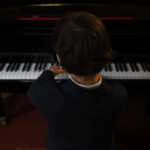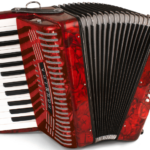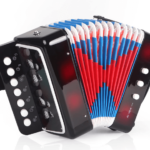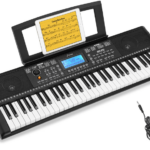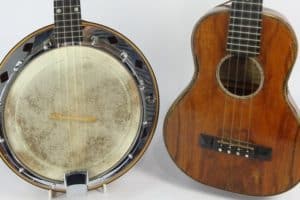Even if the banjo is not as common as the guitar, learning how to play it is just as easy, perhaps even easier. It all depends on the methods that you use to learn it. In this article, I will show you how to play banjo and enjoy the experience at the same time.
To learn how to play banjo, follow these 10 tips:
- Choose a banjo that is easy to play.
- Tune the banjo.
- Learn the proper hand and finger placements.
- Use the right playing posture.
- Learn the basic chords.
- Produce the sound through strumming or plucking.
- Practice rhythm.
- Use online resources.
- Practice regularly.
- Take advanced lessons.
Learning to play the banjo is now easier. It is growing in popularity, and there are more banjo players now than ever before. This could be partly due to the proliferation of banjo lessons from the internet and books.
Read on to learn more about how you can play the banjo even if you are a beginner and know what it takes to be a good banjo player.
Also, we hope you find the links here useful. We may get a commission if you purchase something through a link on this page, so thank you!
Also, for an excellent banjo, take a look at our top pick, the Vangoa 5-String Banjo with Beginner Kit. This banjo is not just a resonator banjo – it can also be an open-back banjo by removing the back. It has a bright, clean style, is lightweight, and comes with essential accessories.
Click here to see it on Amazon.
How to Play Banjo
Click here to see this AKLOT 5 String Banjos Full Size on Amazon.
As a beginner, you don’t have to be afraid that it will take so much effort and time before you can learn to play the banjo. It is not as big as a guitar, although its neck is as long or even longer.
The first step is finding the right banjo for beginners just right for you and then tuning it properly. And then proceed to the learning process, which is discussed in detail in this article. If you put in the required effort and time, you will be able to play simple tunes on a banjo in a short time.
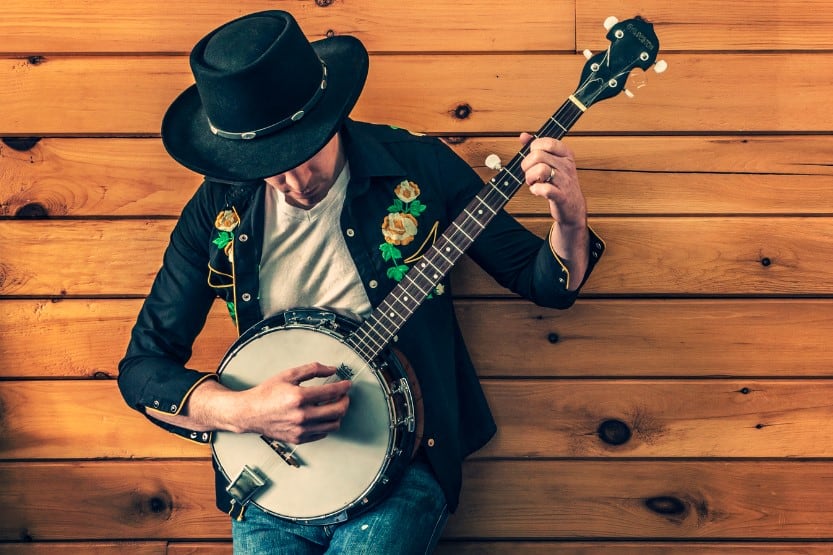
The sounding boards or bodies of banjos are considerably smaller than guitars, much like that of ukuleles, so they are easier to carry and play. Because of their unique material construction, they sound different, making them very interesting to play.
Below are 10 tips to learn how to play banjo quickly and easily.
1. Choose a Banjo That Is Easy to Play
If you want to learn the banjo on your own, you must buy a banjo that is easy to play. This should be your 1st consideration because the instrument you will use may or may not encourage you to pursue such an endeavor.
A banjo for beginners is the best. The banjo should not be hard to learn and play. As you develop the skills and you think that this is for you, that’s the time you can buy a higher quality banjo. Don’t buy it because it looks good. Check and see if it sounds good. Inspect if the build quality is good as well.
You have the option to buy a 4, 5, or 6-string banjo. Pick one that suits the music style you want to play and how much you want to advance in banjo playing. Four strings are mostly for Irish music or Dixieland/jazz.
Five-string banjos are mostly played in folk and bluegrass styles. They can be used in most music styles. Six-string banjos are not very common and more of a special genre. It is not recommended for beginners.
With only four strings to worry about, the easiest for a beginner to play is the 4-string banjo. As you progress in your learning, you can go to 5 strings and later on to 6 strings for more advanced learning.
Resonator Banjo vs Open-back Banjo
You also have a choice between the resonator banjo and the open-back banjo. The resonator type can amplify the sound while the open-back cannot. Additionally, take into account the action of the banjo and the scale or length of the instrument.
A lower action is better for a beginner since you won’t need to press your fretting fingers too much on the fretboard to produce the sounds. Choose a scale that is comfortable enough for you to reach and play.
An excellent banjo that can be a resonator or open back is the Vangoa 5-String Banjo with Beginner Kit.
Click here to see it on Amazon.
This banjo is not just a resonator banjo – it can also be an open-back banjo by removing the back. The resonator banjo produces a softer, mellower sound, while the open-back banjo style produces a very bright sound. These two different banjo styles can meet the different demands of banjo players.
Banjo Styles
The banjo style will also affect the way you learn at the beginning. Two banjo styles are the most common: the clawhammer style and the bluegrass Scruggs style. They say that the clawhammer style is easier to learn because if you know the clawhammer style of playing, everything else will be easier.
2. Tune the Banjo
Before learning how to play the banjo, you must know how to tune it properly. Tuning the instrument means turning the tuning knobs at the headstock so that the strings will be at their proper pitches. The tighter you turn the knob, the higher the pitch of the strings will be and vice versa.
The easiest way to tune your banjo is to use an electric tuner. This is a very inexpensive gadget that will help you correctly tune your banjo every time. Set the tuner to chromatic because that’s what banjos require.
The traditional way of tuning is more elaborate. You need to learn it to deepen your skills and knowledge about musical instruments, not just the banjo. You can use a keyboard or piano as your basis for the correct pitches.
The tenor or 4-string banjo is commonly tuned in this way: G-D-A-E or C-G-D-A. The 5-string banjo is tuned this way: Open G (i.e., D-G-B-D.). The plectrum banjo is commonly tuned in this manner: C-G-B-D.
Knowing how to tune your banjo manually will allow you to discern if your instrument is in tune or out of tune. You can also tune your banjo by matching open strings with fretted strings, like what some guitarists do in tuning their guitars.

3. Learn the Proper Hand and Finger Placements
When playing the banjo, your right hand should be placed above the strings close to the bridge. Moreover, your left hand should be holding the neck. The ring and pinky fingers on your right hand should be resting on the banjo’s round head, just over the first string.
They should stay there while you are playing. This is the standard hand and finger placement for right-handed players. Left-handed players can use these placements or do it in reverse if they want to. But in the violin, they can do it the standard way, as there are no violins for the left-handed.
Keep the thumb of your fretting hand straight and placed on the ‘crown’ at the backside of the neck. The banjo’s weight should also be carried by the banjo strap and not by your left hand. The banjo’s position should not change even if you are not holding it with either of your hands.
4. Use the Right Playing Posture
Strike the correct posture when playing the banjo, whether you are sitting or standing. If your posture is incorrect, it will affect the sound coming from the banjo. It will be more difficult to play the banjo, and it may even hurt your fingers.
Use a banjo strap. These instruments are also somewhat heavy, so you need a strap to carry their weight. Keep your shoulders back and up. Don’t slouch and don’t hold the neck too tight because this will cause your notes to go out of tune.
When playing, the banjo should be held at a 45-degree angle, whether you are sitting or standing. Many players hold the neck of their banjos at the one o’clock position with its bottom slightly tilted upwards so they can see the strings.
5. Learn the Basic Chords
Start by learning the basic chords. You can easily learn the chords if you start with easy melodies, especially those you are already familiar with.
Don’t start by doing complicated rolls. That is a sure way for you to get discouraged and turn your back on the banjo altogether. The chords you must start with should allow you to hear the melodies so you can easily follow.
You can make a banjo chord when you pick or strum two or more strings. The easiest banjo where you can make a chord is the 5-string banjo. Its standard tuning is the open G. If you pick or strum this banjo, you will be playing the G chord without fretting your fingers on any of the frets. This is the reason why the 5-string banjo is recommended for beginners.
The next banjo chords that you should learn are the C chord and the D7 chords. The reason is that they are the chords that are most widely used in banjo playing. If you learn these chords, you’ll be able to play a lot of banjo songs right away.

When it comes to learning how to play a banjo, you need to learn the basic chords. Two common banjo chords are the C chord and D7 chord.
C Chord
For the C chord, you have to do the following:
- Put your middle finger on the 2nd fret of the 4th string. This is called fretting.
- Leave the third string open.
- Fret the first fret of the 2nd string using your index finger.
- Fret the second fret of the 1st string using your ring finger.
- Strum or pick all the five strings, and you will hear the C chord.
D7 Chord
To make the D7 chord, do the following:
- Leave the 4th string open.
- Fret the second fret of the 3rd string using your middle finger.
- Fret the first fret of the 2nd string using your index finger.
- Leave the 1st string open.
- Pick or strum all the five strings to hear the sound of a D7 chord.
Don’t confuse the strings from each other. The first string nearest you is the 5th string. It is the shortest string of all five strings. Now, go down the set of strings to get to the 4th, 3rd, and 2nd strings. The farthest from you is the 1st string.
This video shows how you can form these chords on the banjo with your fingers:
How hard is it to play the banjo? The banjo is not hard to play with patience and consistent practice. Once you learn the proper hand and finger placement, it will be much easier to play the banjo.
6. Produce the Sound Through Strumming or Plucking
You can produce sounds from the banjo in two ways: strumming or brushing and clawhammer or frailing. There are banjo players who also do fingerpicking on their banjos.
You can strum the banjo with your fingers or with a pick. It is usually done with the thumb of the right hand for right-handed players. You can also brush your right thumb across the strings. This is a simple way of checking the tuning of the banjo.
Strumming Patterns
When it comes to learning how to play the banjo, you should also learn the strumming patterns. Watching videos of banjo players will give you an idea of these patterns and how they are done.
Clawhammer or frailing is similar to gently knocking your hands on the door. The strings are plucked or hit in a downward motion. Most guitar finger styles will hit the strings in an upward motion.
In fingerpicking, sweep your fingers downwards using your nail to pluck the strings. You’ll use your thumb, index finger, and middle finger to pluck the strings. Some advanced banjo players pluck the strings using their three fingers.
You can do this if you have already mastered the simple fingerpicking techniques. There are picks that you can buy to slide on your thumbs and fingers. Using picks will help you produce better sounds.
Learn to play basic rolls. Rolls are basically banjo-picking patterns done in eighth notes. These rolls are played in repetitive patterns. But as a beginner, you can initially start with the most basic, which is the forward roll.
This roll is played by hitting the banjo strings in this order: 5-3-1-5-3-1-5-3. The numbers are the string numbers, specifically the 5th, 3rd, and 1st strings. As you can see, you have to play eight notes. That constitutes one roll. After you have mastered this roll, you can go to other kinds of rolls or fingerpicking styles.
7. Practice Rhythm
Playing music is also about keeping time. That is rhythm. If you find it difficult to keep up with the beat of the music piece you are practicing, use a metronome. This little device will help you be in time with the beat, whether the music is in 4/4 or 3/4.
8. Use Online Resources
Take advantage of the teaching resources available online. There are free video lessons that can help you learn banjo playing, from the basics up to the advanced level. On YouTube, you’ll find hundreds of video lessons on banjo playing. Make use of them as most of them are free.
You can also buy a book about banjo playing. It will serve as your banjo lessons in hard copy. The book will also help reinforce the concepts that you have learned from the video lessons.
9. Practice Regularly
You will only advance in your learning if you regularly practice the concepts that you have learned. So, schedule a regular practice. It can be thrice a week at the very least. But since you are just starting, it is best if you can practice every day. Just put in about 15 to 30 minutes, and you will see positive results soon enough.
10. Take Advanced Lessons
If you are religious in your practice schedule, you will experience some improvements. Assess yourself and see if you are now able to take more advanced lessons. Your original objective is to learn to play the banjo. Now that you know how to play it, who can stop you from being a virtuoso banjo player?
Click here to see this Kmise Banjo Ukulele Concert Size on Amazon.
Conclusion – How to Play the Banjo (for Beginners)
If you follow the steps below, you’ll be able to play the banjo, even if you haven’t played it before:
- Choose a banjo that is easy to play.
- Tune the banjo.
- Learn the proper hand and finger placements.
- Use the right playing posture.
- Learn the basic chords.
- Produce the sound through strumming or plucking.
- Practice rhythm.
- Use online resources.
- Practice regularly.
- Take up advanced lessons.
Read next:





